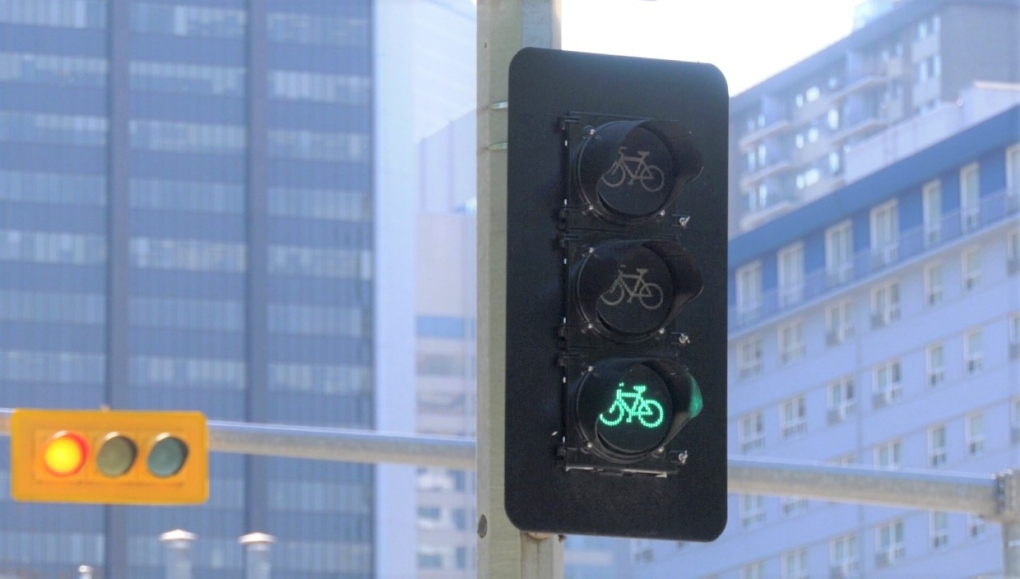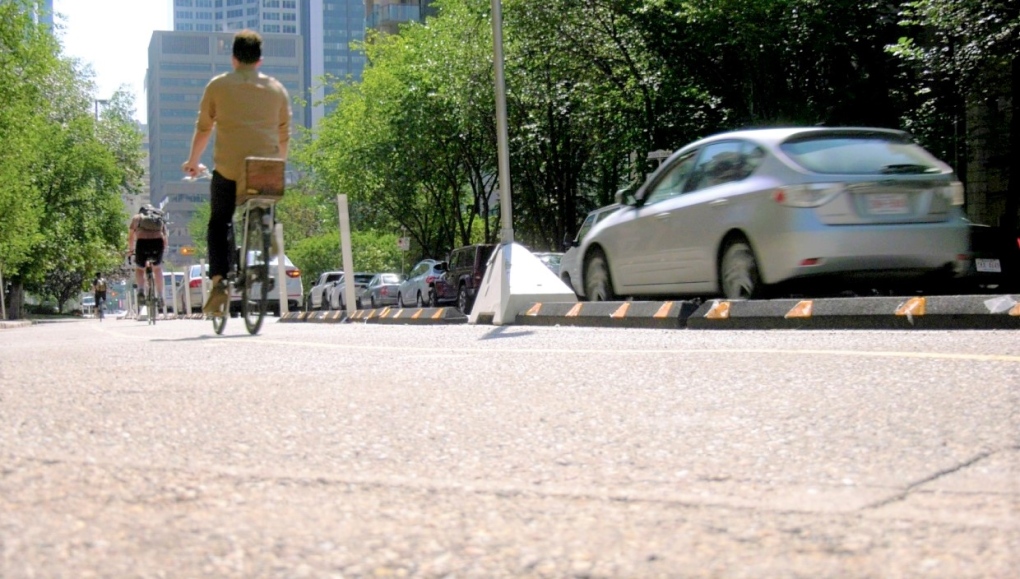Petition launched to prevent Calgary from removing 3rd Avenue cycle track
A grassroots group of Calgarians has put forth an online petition in an effort to prevent the city from eliminating the Third Avenue South cycle track downtown, which is slated for removal in the fall.
Officials with the city say the project, which was installed in 2021, was intended to maintain a protected east-to-west connection for cyclists downtown because of planned construction in the Eau Claire area.
Project manager Dennis Hoffart says the city was open to permanent or temporary infrastructure at the time, but noted that feedback was 50/50.
Peter Oliver, a volunteer with Project Calgary, says the city’s plan to remove the cycle track was not clear from the initial engagement, and thousands of cyclists were under the impression it would stay.
"So, we launched a petition calling on the City of Calgary to scrap its plans to rip out the cycle track, which is part of strategic investments of the downtown strategy," said Oliver.
"(The track) is needed to help make this area more livable, more accessible and safer to move about.
"There's a number of office-to-residential conversions that the city is spending $80 million on to subsidize to make downtown have a higher number of people living here. What they're doing by ripping this out, is making this area less attractive for people to come and live and visit."
The online petition had garnered more than 800 signatures by Wednesday afternoon.
 Some Calgarians are displeased with the city's plan to remove the Third Avenue south cycle track. Oliver adds that the removal of the cycle track "flies in the face of the city’s downtown and climate change strategy," noting that there is greater demand for cycling downtown.
Some Calgarians are displeased with the city's plan to remove the Third Avenue south cycle track. Oliver adds that the removal of the cycle track "flies in the face of the city’s downtown and climate change strategy," noting that there is greater demand for cycling downtown.
Project Calgary filed a Freedom of Information and Privacy (FOIP) request, uncovering two documents; one from the city and another from a local transportation and planning engagement firm.
The documents show a six-fold increase in the number of cyclists with an average of 110 daily bicycles using the bike lane in 2022. A second, undisclosed report shows that the increase in the number of people cycling on Third Avenue South did not impact parkade operations along the avenue either.
Hoffart noted that those documents were only to evaluate the success of the detour project, which was installed using a temporary design and using temporary materials not intended to have long-term durability.
The City of Calgary is preparing to report back to the community with its findings once the temporary detour project has run its course in September.
Officials add that the removal of the cycle track detour on Third Avenue does not impact a potential future project to install permanent infrastructure for cyclists.
IMPACT TO PARKING AND LOCAL BUSINESS
Local business owner James Buchanan, who owns Buchanan’s Chop House on Third Avenue, and although he’s an avid cyclist himself, he says he will be happy to see the city remove the bike lanes.
"There's a lot of businesses and a lot of residents on this block who were not consulted the moment that the bike path went in.
"For us personally, we lost 31 parking spots between these two corners," he said.
"It’s great, there's biking, excessive accessibility and micro mobility to our place, but truthfully, the bike paths are used really significantly three months a year."
 Some Calgarians are displeased with the city's plan to remove the Third Avenue south cycle track. Buchanan also mentioned that a one-way street has made it particularly difficult for businesses to offer access to their clients in the winter months, as many of their clients use a car to drive to the area.
Some Calgarians are displeased with the city's plan to remove the Third Avenue south cycle track. Buchanan also mentioned that a one-way street has made it particularly difficult for businesses to offer access to their clients in the winter months, as many of their clients use a car to drive to the area.
Oliver disagrees, citing a shift for Calgarians to introduce different modes of transportation to their daily commutes.
"We have the largest single employer on Third Avenue, which is Rogers and Shaw Communications, and they have shared a letter of support for the cycle track," said Oliver.
"They see it as a way for their employees to return to the office safely and to be able to have alternative modes of transportation to arrive here, and also to support their environmental and sustainability goals as an organization."
CTVNews.ca Top Stories

Man responsible for New Year's truck attack previously visited New Orleans, Ontario, Egypt: FBI
The man responsible for the truck attack in New Orleans on New Year's Day that killed 14 people visited the city twice before and recorded video of the French Quarter with hands-free glasses, an FBI official said Sunday.
WATCH Woman, 50, critically injured in explosive Ottawa crash caught on camera, police looking for witnesses
Dashcam footage sent to CTV News shows a vehicle travelling at a high rate of speed in the wrong direction before striking and damaging a hydro pole.
Maserati driver seriously injures 2 in Surrey hit-and-run: police
The driver of a Maserati fled the scene of a crash in Surrey that left two people seriously injured Saturday night, according to authorities.
Thousands are without power due to winter storm hitting Newfoundland and Labrador
More than 9,000 Newfoundland Power customers are in the dark on Sunday as the province faces a winter storm with snow, rain and strong winds.
Man rushed to hospital after motorcycle accident at North American International Motorcycle Supershow: paramedics
A man is in serious condition following a motorcycle accident at the North American International Motorcycle Supershow, according to paramedics.
Here’s why you should monitor your blood pressure, keep it in check
An Ottawa pharmacist says blood pressure is a good indicator of overall health, noting the importance of keeping it at healthy rates.
Young driver clocked at nearly 100 km/hr over speed limit
A 21-year-old male driver was stopped by an OPP officer for travelling more than twice the speed limit in a community safety zone in Caledon.
Heaviest snowfall in a decade possible in some areas as winter storm threatens U.S.
A blast of snow, ice, wind and plunging temperatures stirred up dangerous travel conditions in parts of the central U.S. on Sunday, as a disruptive winter storm brought the possibility of the 'heaviest snowfall in a decade' to some areas.
'It keeps you up at night': Effects of postal strike linger into 2025, business owners say
The Canada Post strike ended last month, but the disruption continues to harm businesses at the start of the new year.






























